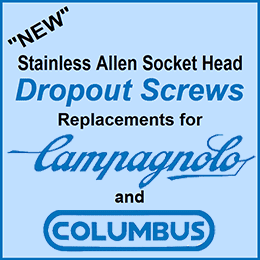Finally, a mini-pump that actually works.
 Tue, November 17, 2015
Tue, November 17, 2015  Bicycle tires, especially clincher tires, have greatly improved in the last twenty years or so. Back in the 1980s if you wanted a high performance tire for your high performance bike, you had to go with tubular tires, or sew-ups as they are called in the US. For the non-racing leisure rider this was a huge hassle and expense.
Bicycle tires, especially clincher tires, have greatly improved in the last twenty years or so. Back in the 1980s if you wanted a high performance tire for your high performance bike, you had to go with tubular tires, or sew-ups as they are called in the US. For the non-racing leisure rider this was a huge hassle and expense.
Today there is a wide range of performance clinchers to choose from, but a simple portable air pump to carry on the road, along with a spare inner tube and/or a patch kit. One that will put enough air in the tire to get you home in an emergency. Not so easy to find.
 Most real bike enthusiasts have a floor pump (Track Pump.) to air up their tires at home.
Most real bike enthusiasts have a floor pump (Track Pump.) to air up their tires at home.
But the full length frame fit pump, the kind one could use to beat off an attacking dog, disappeared when lugged steel frames disappeared.
Such a pump would pump up your tires, in fact in the old days it was all we had, and our pressure gauge was our thumb and forefinger.
The mini-pump has taken over from the full length pump, but if it won’t pump your tires up when needed, what use is it?
I have been struggling with such a mini-pump for at least two or three years. Like most of its kind it has a push-on air chuck that can be adapted (By reversing a rubber washer.) to fit either a Schrader or the smaller Presta road tire valve.
 My first emergency road side flat, the pump was letting air out of the tire as fast as I was pumping it up.
My first emergency road side flat, the pump was letting air out of the tire as fast as I was pumping it up.
Then I found I had bent the valve pin in the Presta valve. In trying to straighten it, it broke off and I had to start over with a second spare inner tube.
I then bent the second valve pin, but did not attempt to straighten it and got enough air in the tire to get me home.
After that I realized this pump was only good for putting a little air in the tube so it didn’t get pinched when fitting the clincher tire over the rim. I used a CO2 pump to bring the tire up to full pressure.
So when I was recently offered the “Road Air” mini-pump to try out, I was pleased to see it had a simple, ‘old tech’ screw on flexible connector. The kind of connector pumps had from day one when the pneumatic tire was invented in 1887, and worked fine for the next 100 years. (Picture below.)
The built in push-on connector has been around since at least the 1930s and also worked fine with the full length pump. It was born out of necessity like the quick release hub because of racing. Even the professional riders had to change their own tubular tire, and pump it up, in races like the Tour de France. Picture below, Romain Maes pumping up a tire with a push on air chuck, in the 1936 TDF.

This “Deal with your own punctures,” regulation was still in place in professional racing throughout the 1950s. It was done in the interest of fairness because not all teams had a full support vehicle. In amateur races it went on into the 1980s, in all but the top races.
By the 1980s the Silca, frame fit pump was popular. It came in various lengths so you could buy one to fit your frame. Back in the day I painted many Silca pumps to match the frame. (Below.)

So a pump is no longer needed for racing, and the urgency to get a tire pumped up quickly is not the problem. The issue is, get the tire pumped up and get home. The built in push on air chuck is no longer needed on a mini-pump, and they don’t work anyway.
The reason. With a full length pump, one is pumping with long slower strokes. Because of the leverage it was easy to keep the air chuck firmly on the valve with one hand, while pumping with the other. Because a mini-pump is only 8 or 9 inches long, it is necessary to pump in fast short (Almost frantic.) strokes, and it is almost impossible to hold the air chuck steady, hence my experience with bent valve pins.
The flexible rubber connector on the “Road Air” pump is under a neat little plastic dust cap. Lift the dustcap and the connector unscrews from pump to extend it, but remains attached to the pump. It fits a Schrader type valve, and you have to use the Presta adaptor (Provided.) for a road bike.
 (Above.) The handle opens up, and contains a Presta adaptor, a needle connector for blowing up soccer balls, and a plastic nozzle for blowing up anything else that needs air. The compartment in the handle is quite hard to open and my first attempt it came off suddenly and the contents went flying. Had I been at the roadside the Presta adaptor would have been lost in the long grass with all the other parts.
(Above.) The handle opens up, and contains a Presta adaptor, a needle connector for blowing up soccer balls, and a plastic nozzle for blowing up anything else that needs air. The compartment in the handle is quite hard to open and my first attempt it came off suddenly and the contents went flying. Had I been at the roadside the Presta adaptor would have been lost in the long grass with all the other parts.
 I found it best to lever open the handle with a small pen knife I always carry on my key ring. (Left.)
I found it best to lever open the handle with a small pen knife I always carry on my key ring. (Left.)
I always have a spare Presta adaptor in my patch kit anyway, so I’m covered.
I would prefer a Presta valve only version, and I don't need all the other stuff.
The maker would save money on a plain handle instead of one that opens.
There are enough road bike enthusiasts out there, I would expect there to be a good market.
 When this little pump arrived, I let all the air out of one of my tires and connected it up.
When this little pump arrived, I let all the air out of one of my tires and connected it up.
Two minutes of fast pumping and my thumb and forefinger told me there was enough pressure in the tire to get me home if I was on the road.
The pump comes with a little carrying bracket that fits on a water bottle mount. I prefer to carry it in my pocket.
The two minutes it took me to pump up my tire, was the time it took to sell me on this pump. It pumped my tire up, that’s all I ask. This is a great little pump.
Buy the Road Air Pump here. Reasonably priced at $24.95 and comes with a lifetime guarantee.
To Share click "Share Article" below
 Dave Moulton | Comments Off |
Dave Moulton | Comments Off | 

















Reader Comments (13)
Greg Lemond I think it was? blows tubes up with his breath! I always use a CO2 Buy the tube off Ebay in boxes of 50 or so, costs about $1 each. Thought you rode tubs Dave. I use sealant in tubs seem to work on all but the biggest ole. carry Vittoria pit stop works fune but messy.
I don't like the mini pumps either. I don't like having to use an adapter. I do like that I can still buy serviceable parts to keep both Silca frame pumps operational! I do carry a CO2 solution with me too.
As much as clinchers have improved, I am moving back to sew ups! They are as fast or faster to change on the road as an inner tube. The ride is still superior in my book.
The one time i tried to use a mini pump, i nearly wound up having to walk home. They are in my book one of the biggest jokes ever pulled on cyclists. However with the current trend in frame design leaving no good way to mount a full length fitted inflator most cyclists are stuck with the joke jutting from a pocket that could be better used to carry food or IDs...
Two minutes of manic pumping, maybe longer if one is trying to inflate a mountain bike tyre seems to me an execise in futility.
i was happy to learn recently that Zefal had put their HPX frame fit pump back in production. It has an alloy body and locking chuck and can hit 100+ psi in jig time. It has saved me that long walk home more than once. As long as i own bikes than can accommodate a proper frame pump, i will swear by and use this fine pump.
As for CO2 inflators, i'm sure they are okay for most people, but what does one do when one suffers one more puncture than the number of cartridges in their kit and they're miles from nowhere?
How about Lezyne mini pumps? They are more expensive than the one you showed here but they are made out of high quality materials (no plastics). What I like about them most is that they come with a flex tubing that screws onto Presta or Schrader valves without any adapters required. This makes pumping tires much easier as you don't have to hold the pump tight against the valve.
I use one with 35 mm tires and it works great.
I'll second the Lezyne pumps. If you want they also offer an inline air pressure gage that is part of the flex tube, and it actually works.
The one that I have is a little larger that the one you show, but it really does pump.
I have a Topeak Road Morph G mini-pump on both of my bicycles. It works with Schrader, Presta or Dunlop, has an integral guage, T-handle, and fold out foot pad. It comes with a bracket that mounts to water bottle bosses. It costs about thirty-five dollars American. There is a less expensive version without the guage. I can put 8 ATM in my tire quite easily; more easily than I can with the longest Silca frame pump made. It does weigh more than a Silca or other mini-pumps, but weight isn't an issue for a senior citizen casual rider (me) on a steel (or carbon fiber) bicycle. This was the only pump I owned for a couple of years. Disclaimer: I am not an employee of Topeak.
I use this one Lezyne Road Drive Mini ABS Pump
http://www.wiggle.com/lezyne-road-drive-mini-abs-pump/
Mount it off the water bottle though not in the pocket.
Works great. So I guess thats a third for the Lezyne.
Another vote for Lezyne pumps. High quality. I use the one that adapts to CO2 cartridges so that you can either pump or use the cartridge. I carry one cartridge with me, and pump after that.
Another vote for Lezyne. I have used Lezyne mini and floor pumps for a few years...the best!
Yep, another vote for the Lezyne hand/frame pump series. Owned a few, both road (HP) & MTB (HV) versions. The flexible 'anti bleed system (ABS) tube is very similar at first glance to the unit Dave is featuring here - but it's screw on attachement to the presta head and the inbuilt relief valve saves you losing pressure when it comes to detatching.
Rugged little things. I've only ever owned the CNC'ed aluminium units and found them easy to pull apart, clean, rebuild and swap parts when occasionally necessary.
I have a couple of hand-me down Zefal HPX frame pumps, which I know have/had their exponents for a long time - but even if they do take less time to inflate to your given pressure, I disliked the rigid head-to-valve system personally.
Looking at the TdF photo I must say that not only have tires improved but so have the road surfaces they roll on.
Like the majority of Lezyne products the Road Drive Pump is a high-quality pump. I have use it and I highly recommend it.
Hi Guys!
Did any of you ever purchase iPUMP Micro, the lightest air pump in the world, made in Japan. We would love to hear from you. We have 3 types, iPUMP Micro 21gr, iPUMP Twist 25gr, iPUMP Floor 35gr. Our website is ipump.jp. We had 3 successful Kickstarter projects and fantastic reviews. We love to hear from you.
Ride safely!
Morris